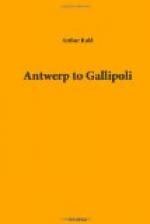When the ships pushed on up the strait toward Kilid Bahr and Chanak Kale—somewhat like trying to run the Narrows at New York—there was a different story. They were now within range of shore batteries and there were anchored mines and mines sent down on the tide. On March 18 the Irresistible, Ocean, and Bouvet were sunk, and it began to be apparent that the Dardanelles could not be forced without the help of a powerful land force. So in April landing parties were sent ashore: at Kum Kale and Sedd ul Bahr, at Kaba Tepe and Art Burnu, some twelve or fourteen miles farther north on the Aegean side of the peninsula, and at another point a few miles farther up. At Sedd ul Bahr and along the beach between Kaba Tepe and Art Bumu the Allies made their landing good, dug themselves in, and, reinforced by the fire of the ships, began a trench warfare not unlike that which has dragged on in the west.
The peninsula is but ten or twelve miles wide at its widest, and the Dardanelles side is within range of the fleet’s great guns, firing clear overland from the Aegean. It was by this indirect fire that Maidos was destroyed and Gallipoli partly smashed and emptied of its people. There were places toward the end of the peninsula where Turkish infantrymen had to huddle in their trenches under fire of this sort coming from three directions. Whenever the invaders had it behind they were naturally at an advantage; whenever it ceased they were likely to be driven back. The Turks, on the other hand, had the advantage of numbers, of fighting on an “inside line,” and of a country, one hill rising behind another, on the defense of which depended their existence as a nation in Europe.
Under these conditions the fighting had been going on for weeks, the English and French holding their ground at Sedd ul Bahr and Ari Burnu, but getting no nearer Constantinople. And as we went chunking down the strait that night and into Ak-Bash in the dark, two new forces were coming in. The next day a German submarine—come all the way round through the Mediterranean—was to sink the Triumph and the Majestic, while another American correspondent, who had intended to come with us but took the transport Nagara instead, saw the head of an English submarine poke through the Marmora. A blond young man in overalls and white jersey climbed out of the conning-tower. “Will you give us time to get off?” cried the American, the only one on board who could speak English.
“Yes,” said the young man, “and be damned quick about it.” Ten minutes later, from the boats into which they had tumbled, the passengers saw a cloud of yellow smoke, and the Nagara simply disintegrated and sank, and with her the heavy siege-gun she was taking to the Dardanelles.
Pleasantly unaware of what might as well have happened to the bread and beans, we drew up to a hill-side speckled with lights, a wharf, and a hospital boat smelling of iodoform, through a cabin window of which a doctor was peacefully eating dinner. Boxes and sacks were piled near the wharf, and from over behind the hills, with startling nearness, came the nervous Crack... crack... crack-crack-crack! of rifle and machine-gun fire.




